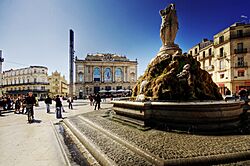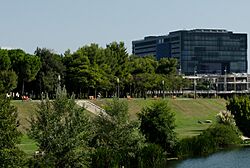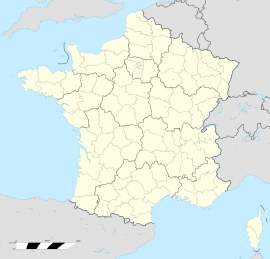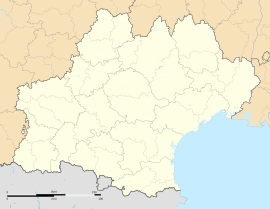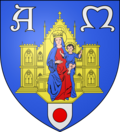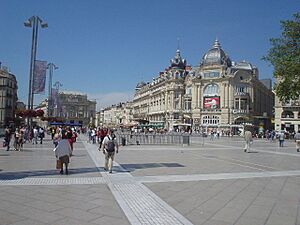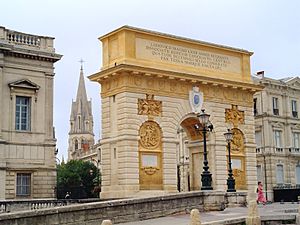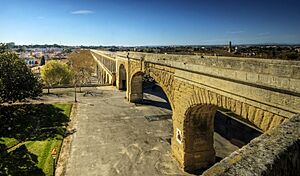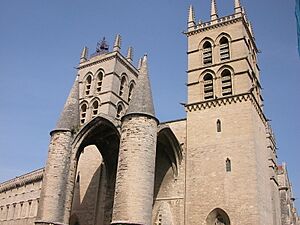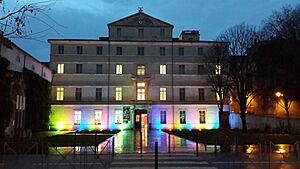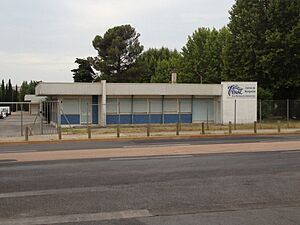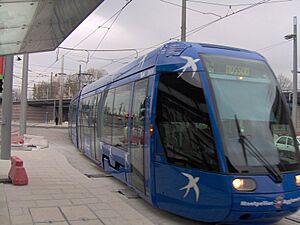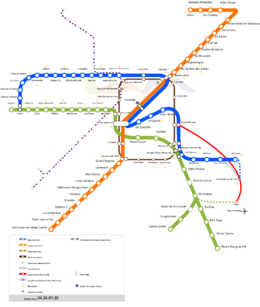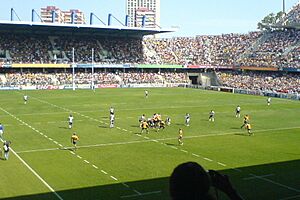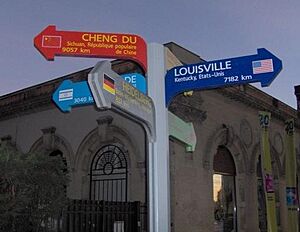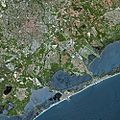Montpellier facts for kids
Quick facts for kids
Montpellier
Montpelhièr (Occitan)
|
|||
|---|---|---|---|
|
Prefecture and commune
|
|||
|
Clockwise from top: The Place de la Comédie, Port Marianne's lake, the bank of the Lez with the Montpellier Town Hall, and the Cathedral of Saint Peter.
|
|||
|
|||
| Country | France | ||
| Region | Occitanie | ||
| Department | Hérault | ||
| Arrondissement | Montpellier | ||
| Canton | Montpellier-1, 2, 3, 4, 5 and Montpellier – Castelnau-le-Lez | ||
| Intercommunality | Montpellier Méditerranée Métropole | ||
| Area
1
|
56.88 km2 (21.96 sq mi) | ||
| • Urban | 310.0 km2 (119.7 sq mi) | ||
| • Metro | 2,414 km2 (932 sq mi) | ||
| Population
(2021)
|
302,454 | ||
| • Rank | 7th in France | ||
| • Density | 5,317.4/km2 (13,772.0/sq mi) | ||
| • Urban
(Jan. 2020)
|
465,950 | ||
| • Urban density | 1,503.06/km2 (3,892.9/sq mi) | ||
| • Metro
(Jan. 2020)
|
813,272 | ||
| • Metro density | 336.90/km2 (872.56/sq mi) | ||
| Demonym(s) | Montpelliérain (masculine) Montpelliéraine (feminine) |
||
| Time zone | UTC+01:00 (CET) | ||
| • Summer (DST) | UTC+02:00 (CEST) | ||
| INSEE/Postal code |
34172 /34000, 34070, 34080, 34090
|
||
| Elevation | 7–121 m (23–397 ft) (avg. 27 m or 89 ft) |
||
| 1 French Land Register data, which excludes lakes, ponds, glaciers > 1 km2 (0.386 sq mi or 247 acres) and river estuaries. | |||
Montpellier is a lively city in southern France. It is located close to the Mediterranean Sea. It is one of the biggest cities in the Occitania region. Montpellier is also the main city, or prefecture, of the Hérault area.
In 2020, about 299,096 people lived in the city itself. Its larger metropolitan area had over 813,272 residents. People from Montpellier are called Montpelliérains.
During the Middle Ages, Montpellier was an important city. It was part of the Crown of Aragon and then Majorca. It was sold to France in 1349. The University of Montpellier was started in 1220. It is one of the oldest universities in the world. It also has the oldest medical school that is still open today. Famous people like Nostradamus studied there.
Since the 1990s, Montpellier has grown very fast. Its population has increased more than any other big city in France since 2000. About 70,000 students live here. This means almost a quarter of the city's population are students! Montpellier is known for its great living environment. It has one of Europe's largest pedestrian areas. It also has a rich cultural life and a nice Mediterranean climate. Because of this, it is sometimes called the "Gifted" city.
Contents
- Discover Montpellier
- A Journey Through Time: Montpellier's History
- Montpellier's Location and Climate
- Montpellier's Neighborhoods
- Population Growth in Montpellier
- Montpellier's Coat of Arms
- Famous Places to See in Montpellier
- Education in Montpellier
- Getting Around Montpellier
- Sports in Montpellier
- Culture and Events in Montpellier
- International Connections
- Famous People from Montpellier
- Places Named After Montpellier
- Images for kids
- See also
Discover Montpellier
Montpellier is the third-largest French city near the Mediterranean coast. Only Marseille and Nice are bigger. It is the seventh-largest city in all of France. For 25 years, it has been the fastest-growing city in the country.
A Journey Through Time: Montpellier's History
How Montpellier Began
In the Early Middle Ages, a nearby town called Maguelone was important. But pirates often attacked it. This made people want to settle further inland. So, Montpellier was founded around 985. It was started by a local ruling family called the Guilhem. They joined two small villages and built a castle and walls. The name "Montpellier" comes from an old Latin name. It means "Woad Mountain." This refers to a plant used for dyeing clothes.
The city had two parts: Montpellier and Montpelliéret. In 1160, a law school was already active here. The two remaining towers of the old city walls, the Tour des Pins and the Tour de la Babotte, were built around 1200.
Growing into a Trading Hub
Montpellier became very important in the 12th century. It was a major trading center. It had trade routes all over the Mediterranean. The city also had a rich Jewish culture. People of different faiths, like Muslims, Jews, and Cathars, lived together peacefully.
In 1180, William VIII of Montpellier allowed anyone to teach medicine in the city. The city's law and medical schools were officially started in 1220. They were approved by Pope Honorius III. The medical school became one of Europe's top places to study medicine.
Royal Connections and French Rule
Montpellier became part of the Kings of Aragon's lands in 1204. This happened when Peter II of Aragon married Marie of Montpellier. The city was part of her dowry. In 1204, Montpellier also received a special charter. This gave the city the right to choose its own leaders.
Under the Kings of Aragon, Montpellier grew even more. It became a major economic center. It was especially known for the spice trade in France. Before the Black Death, about 40,000 people lived there. This made it one of France's biggest cities. In 1349, James III of Majorca sold the city to the French king Philip VI. This helped him pay for his wars. From then on, Montpellier was part of the Languedoc region until the French Revolution in 1789.
Changes After the Reformation
In the 16th century, during the Reformation, many people in Montpellier became Protestants. They were also known as Huguenots. The city became a strong center for Protestants against the Catholic French crown. In 1622, King Louis XIII attacked the city. After two months, the city surrendered. He then built the Citadel of Montpellier to control it.
Later, Louis XIV made Montpellier the capital of Bas Languedoc. The city began to add beautiful new features. These included the Promenade du Peyrou and the Esplanade. Many grand houses were also built in the old city center. After the French Revolution, Montpellier became the capital of the smaller Hérault department.
Modern Growth and Student Life
In the 19th century, Montpellier became rich from growing wine. The warm climate helped produce a lot of grapes. But in the 1890s, a disease called phylloxera damaged the vineyards. This hurt the wine industry.
Later, the city grew again. Many French people returned from Algeria and other parts of North Africa after Algeria became independent. In the 21st century, Montpellier is one of France's top ten largest cities. It has seen another big increase in population recently. This is mainly due to its large student population. The medical school helped start the city's strong university culture. Many other universities have also been built here. The city has also benefited from big building projects. These include the Antigone, Port Marianne, and Odysseum areas.
Montpellier's Location and Climate
Where is Montpellier?
The city is built on hills about 10 km (6 miles) inland from the Mediterranean coast. It sits on the Lez River. The city's name, Monspessulanus, might mean "naked hill." This is because the early area had little plant life.
Montpellier is about 170 km (106 miles) from Marseille. It is 242 km (150 miles) from Toulouse. Paris is about 748 km (465 miles) away.
The highest point in Montpellier is the Place du Peyrou. It is about 57 meters (187 feet) high. The city is built on two hills, Montpellier and Montpelliéret. This means some streets have big changes in height. Many streets are also very narrow and old. This gives the city a cozy and historic feel.
Weather in Montpellier
Montpellier has a Mediterranean climate. This means it has cool, wet winters. Summers are hot and quite dry. The average temperature in January is 7.6°C (45.7°F). In July, it's 24.4°C (75.9°F).
The city gets about 639 mm (25 inches) of rain each year. Most rain falls in autumn and winter. But it can rain a little in summer too. The coldest temperature ever recorded was -17.8°C (0°F) in February 1963. The hottest was 43.5°C (110.3°F) in June 2019.
| Climate data for Montpellier (MPL), elevation: 1 m (3 ft), 1991–2020 normals, extremes 1946–present | |||||||||||||
|---|---|---|---|---|---|---|---|---|---|---|---|---|---|
| Month | Jan | Feb | Mar | Apr | May | Jun | Jul | Aug | Sep | Oct | Nov | Dec | Year |
| Record high °C (°F) | 21.2 (70.2) |
23.6 (74.5) |
27.4 (81.3) |
30.4 (86.7) |
35.1 (95.2) |
43.5 (110.3) |
37.6 (99.7) |
37.7 (99.9) |
36.3 (97.3) |
31.8 (89.2) |
27.1 (80.8) |
22.0 (71.6) |
43.5 (110.3) |
| Mean maximum °C (°F) | 18.0 (64.4) |
19.1 (66.4) |
23.0 (73.4) |
25.4 (77.7) |
29.5 (85.1) |
33.9 (93.0) |
34.7 (94.5) |
34.4 (93.9) |
31.1 (88.0) |
26.1 (79.0) |
21.1 (70.0) |
18.0 (64.4) |
35.8 (96.4) |
| Mean daily maximum °C (°F) | 12.0 (53.6) |
13.1 (55.6) |
16.4 (61.5) |
18.7 (65.7) |
22.6 (72.7) |
26.9 (80.4) |
29.5 (85.1) |
29.3 (84.7) |
25.2 (77.4) |
20.7 (69.3) |
15.7 (60.3) |
12.5 (54.5) |
20.2 (68.4) |
| Daily mean °C (°F) | 7.6 (45.7) |
8.3 (46.9) |
11.4 (52.5) |
13.9 (57.0) |
17.8 (64.0) |
21.8 (71.2) |
24.4 (75.9) |
24.1 (75.4) |
20.2 (68.4) |
16.4 (61.5) |
11.6 (52.9) |
8.3 (46.9) |
15.5 (59.9) |
| Mean daily minimum °C (°F) | 3.3 (37.9) |
3.5 (38.3) |
6.4 (43.5) |
9.2 (48.6) |
12.9 (55.2) |
16.7 (62.1) |
19.3 (66.7) |
19.0 (66.2) |
15.2 (59.4) |
12.2 (54.0) |
7.4 (45.3) |
4.1 (39.4) |
10.8 (51.4) |
| Mean minimum °C (°F) | −3.3 (26.1) |
−2.8 (27.0) |
0.2 (32.4) |
4.1 (39.4) |
7.7 (45.9) |
12.1 (53.8) |
15.3 (59.5) |
14.4 (57.9) |
9.9 (49.8) |
5.1 (41.2) |
0.1 (32.2) |
−3.3 (26.1) |
−5.1 (22.8) |
| Record low °C (°F) | −15.0 (5.0) |
−17.8 (0.0) |
−9.6 (14.7) |
−1.7 (28.9) |
0.6 (33.1) |
5.4 (41.7) |
8.4 (47.1) |
8.2 (46.8) |
3.8 (38.8) |
−0.7 (30.7) |
−5.0 (23.0) |
−12.4 (9.7) |
−17.8 (0.0) |
| Average precipitation mm (inches) | 56.2 (2.21) |
39.2 (1.54) |
41.5 (1.63) |
55.8 (2.20) |
44.0 (1.73) |
32.9 (1.30) |
17.1 (0.67) |
35.9 (1.41) |
86.7 (3.41) |
94.7 (3.73) |
78.1 (3.07) |
57.1 (2.25) |
639.2 (25.17) |
| Average precipitation days (≥ 1.0 mm) | 5.8 | 4.1 | 4.6 | 5.8 | 5.2 | 3.6 | 2.5 | 3.4 | 4.5 | 6.2 | 6.7 | 5.5 | 57.8 |
| Average snowy days | 0.7 | 0.4 | 0.1 | 0.0 | 0.0 | 0.0 | 0.0 | 0.0 | 0.0 | 0.0 | 0.1 | 0.2 | 1.5 |
| Average relative humidity (%) | 75 | 73 | 68 | 68 | 70 | 66 | 63 | 66 | 72 | 77 | 75 | 76 | 71 |
| Mean monthly sunshine hours | 145.6 | 170.1 | 218.8 | 228.6 | 271.4 | 315.7 | 344.8 | 305.1 | 246.6 | 175.5 | 145.7 | 137.4 | 2,705.2 |
| Source 1: Météo France (snow 1981–2010) | |||||||||||||
| Source 2: Infoclimat (humidity 1961–1990, annual extremes 1991–2020) | |||||||||||||
Montpellier's Neighborhoods
Since 2001, Montpellier has seven main neighborhoods. Each of these is divided into smaller areas. They all have their own local councils.
- Montpellier-centre: This is the historical heart of the city. It includes areas like Écusson, Comédie, and Les Beaux-Arts.
- Croix-d'Argent: This area includes Mas Drevon, Lemasson, and Estanove.
- Les Cévennes: Here you'll find Alco, Le Petit Bard, and La Martelle.
- Mosson: This neighborhood includes Celleneuve, La Paillade, and Les Hauts-de-Massane.
- Hôpitaux-Facultés: This area is home to many hospitals and university buildings. It includes Malbosc and Universités.
- Port-Marianne: This is a newer area with modern buildings. It includes Richter, Millénaire, and Odysseum.
- Prés d'Arènes: This neighborhood has areas like La Rauze, Tournezy, and Saint-Martin.
Population Growth in Montpellier
The entire metropolitan area of Montpellier had 813,272 people in 2020. A study from 2007 to 2012 showed that Montpellier had the fastest population growth among France's main cities. It grew more than Paris and Lyon.
For much of its history, Montpellier has had a large Spanish population. It also has many Moroccan, Algerian, and Italian communities.
| Historical population | |||||||||||||||||||||||||||||||||||||||||||||||||||||||||||||||||||||||||||||||||||||||||||||||||||||||||||||||||||
|---|---|---|---|---|---|---|---|---|---|---|---|---|---|---|---|---|---|---|---|---|---|---|---|---|---|---|---|---|---|---|---|---|---|---|---|---|---|---|---|---|---|---|---|---|---|---|---|---|---|---|---|---|---|---|---|---|---|---|---|---|---|---|---|---|---|---|---|---|---|---|---|---|---|---|---|---|---|---|---|---|---|---|---|---|---|---|---|---|---|---|---|---|---|---|---|---|---|---|---|---|---|---|---|---|---|---|---|---|---|---|---|---|---|---|---|
|
|
||||||||||||||||||||||||||||||||||||||||||||||||||||||||||||||||||||||||||||||||||||||||||||||||||||||||||||||||||
| Source: EHESS and INSEE (1968–2017) | |||||||||||||||||||||||||||||||||||||||||||||||||||||||||||||||||||||||||||||||||||||||||||||||||||||||||||||||||||
Montpellier's Coat of Arms
| The arms of Montpellier are blazoned: Azure, a madonna proper, vested gules and azure, sitting on an antique throne Or, holding a Baby Jesus proper vested azure, in chief the uncial letters A and M, and in base on an inescutcheon argent a torteau (gules). The virgin is "Notre Dame des Tables", named for the money changing tables at the Basilica of Notre-Dame des Tables. The A and M are for "Ave Maria". The inescutcheon is the arms of the Lords of Montpellier (Guilhem). |
The coat of arms for Montpellier shows a picture of the Virgin Mary. She is sitting on a golden throne and holding Baby Jesus. Above them are the letters A and M, which stand for "Ave Maria." At the bottom, there is a small shield with a red circle. This small shield represents the old rulers of Montpellier, the Guilhem family.
Famous Places to See in Montpellier
- The main gathering spot is the Place de la Comédie. It features the Opéra Comédie, built in 1888.
- The Musée Fabre is a famous art museum.
- In the old city center, called the Écusson, you can find many beautiful old mansions. Most of these buildings have medieval roots. They were updated between the 16th and 18th centuries.
- The Rue du Bras de Fer (Iron Arm Street) shows what medieval Montpellier looked like.
- The mikve, an old Jewish ritual bath, dates back to the 12th century. It is one of the few old mikves still existing in Europe.
- The Jardin des plantes de Montpellier is the oldest botanical garden in France. It was founded in 1593.
- The La Serre Amazonienne is a greenhouse that looks like a tropical rainforest.
- The 14th-century Saint Pierre Cathedral is a grand church.
- The Porte du Peyrou is a triumphal arch built in the late 17th century. The Place Royal du Peyrou, built in the 17th century, is the highest point in the Écusson.
- The Tour des Pins is the only one left of 25 towers from the city's medieval walls. It was built around 1200.
- The Tour de la Babotte is a medieval tower. It was changed in the 18th century to become an observatory.
- The Saint Clément Aqueduct was built in the 18th century.
- The Antigone District was designed by the famous architect Ricardo Bofill.
- Many beautiful country houses, called châteaux or follies, surround the city. Wealthy merchants built them in the 18th century.
- Nearly 80 private mansions were built in the city center from the 17th to 19th centuries. Some of their inner courtyards are open to visitors.
Education in Montpellier
A Long History of Learning
The University of Montpellier is one of the oldest universities in the world. It was founded in 1160. It received its official charter in 1220. The university was closed during the French Revolution but reopened in 1896.
It's not clear exactly when the first schools of literature began in Montpellier. They might have continued from older Roman schools. The law school was started by Placentinus, a doctor from Bologna University, in 1160.
The medical school became very successful. This was because the Guilhems, the city's lords, allowed any licensed doctor to teach there. This meant there were many teachers and a lot of different courses. Rabelais earned his medical degrees in Montpellier. The medical school continued even during the French Revolution.
The faculties of science and letters reopened in 1810. The law faculty reopened in 1880. In 1889, France decided to reorganize its universities. This happened during the university's 600th anniversary celebration.
Universities Today
- University of Montpellier: This university covers many subjects. These include sciences, medicine, dentistry, pharmacy, law, business, and sports.
- Paul Valéry University: This university focuses on arts, languages, and social sciences.
The University of Montpellier 1 and University of Montpellier 2 joined together in January 2015. They now form the single University of Montpellier. Paul Valéry University Montpellier remains a separate university.
In 2013, Montpellier was ranked as the 119th best student city in the world. This was according to the QS Best Student Cities ranking.
Top Schools in Montpellier
Public Service Schools
- École nationale de la concurrence, de la consommation et de la répression des fraudes (ENCCRF): This is the National School for Competition, Consumer Affairs, and Fraud Control.
Science Schools
- E-Artsup
- École Polytechnique Universitaire de Montpellier (Polytech)
- National Superior Architecture School of Montpellier (ENSAM)
- École nationale de l'aviation civile (ENAC)
- ENSCM: This school focuses on chemistry.
- École pour l'informatique et les nouvelles technologies (EPITECH)
- Institut supérieur européen de formation par l'action (ISEFAC)
- Montpellier SupAgro: This school specializes in agronomy (the science of soil management and crop production).
- SUPINFO International University: A private higher education institution for computer science.
Business Schools
- Montpellier Business School
- SupExup Higher Education Institute
Getting Around Montpellier
Montpellier has good train connections. This includes TGV high-speed trains. The main train station is Saint-Roch. Since 2018, there is also a new station, Montpellier-Sud de France. It is on the high-speed line connecting Nîmes and Montpellier.
The Montpellier – Méditerranée Airport is located southeast of the city. It is in the town of Mauguio.
The Transports de l'agglomération de Montpellier (TaM) manages the city's public transport. This includes its 56 km (35 miles) tramway network. The network has four lines and many parking areas.
- Line 1 runs from Mosson in the west to Odysseum in the east.
- Line 2 runs from Jacou in the northeast to St. Jean-de-Vedas in the southwest.
- Line 3 and Line 4 opened in April 2012.
- Line 3 is 22.4 km (13.9 miles) long. It connects Juvignac and Pérols. It also has a branch to Lattes and serves 32 stations.
- Line 4 goes around the city center. It connects the different tram lines. All lines meet at Gare St. Roch station, Rives du Lez, and Corum.
Since 2019, €440 million has been invested. This is for building a 5th tramway line. It will link the south from Lavérune to Clapiers in the north.
Since December 21, 2023, public transport is free for all residents. Before that, residents under 18 and over 65 years old rode for free since September 1, 2021.
TaM also runs a large bike sharing program called Vélomagg'. It started in June 2007. It has 1200 bicycles and 50 stations.
Sports in Montpellier
Montpellier has hosted parts of the Tour de France bicycle race. It was the finish line for Stage 11 and the start for Stage 12 in 2007 and 2016. The city is home to many professional sports teams:
- Montpellier Hérault Rugby: This rugby union team plays in the Top 14 league. They play at the Altrad Stadium. In the 2010/2011 season, they reached the Top 14 Final.
- Montpellier HSC: This football (soccer) team plays in Ligue 1. They play at the Stade de la Mosson. MHSC became French Champions on May 20, 2012.
- Montpellier Agglomération Handball: This is a major team handball club. They have won the French championship 14 times. They have also won the European Cup twice.
- Montpellier Red Devils: This rugby league team plays in the Elite 1 division. They play at the Stade Sabathé.
- Montpellier Hérault Sport Club Volley-Ball: This volleyball team plays in the LNV Ligue A. They have won 8 national titles.
- Montpellier Vipers: This ice hockey team plays in France's Division 1. They play at the Patinoire de l'Agglomération de Montpellier at Odysseum.
- Montpellier Water Polo: This team plays in the National League and European Cup.
- Barracudas de Montpellier: This is a baseball club. It competes in Division Élite, France's top baseball league.
Montpellier was one of the host cities for the FIBA EuroBasket 2015 basketball tournament. The city also hosts the Open Sud de France tennis tournament since 2010. It will also host the XXXI World Rhythmic Gymnastics Championship.
The main athletics stadium is the Philippidès Stadium. It is owned by the University of Montpellier.
Culture and Events in Montpellier
Montpellier is a center for cultural events. This is because it has so many students. The city has two large concert venues: Le Zenith Sud (7,000 seats) and L'Arena (14,000 seats). Le Corum is a cultural and conference center. It has three auditoriums.
- The Festival de Radio France et Montpellier is a summer festival. It features opera and other music. The festival focuses on classical music and jazz. It has about 150 events. These include opera, concerts, films, and talks. Most events are free. They are held in the city's historic courtyards or in the modern concert halls of Le Corum.
- The annual Cinemed, the International Mediterranean Film Festival Montpellier, is held in the fall. It is the second largest French film festival after the Cannes Film Festival. It has been held since 1979. It shows over 200 long and short films, documentaries, and animated films. It also has a special program of student films. Other events include discussions, exhibitions, and gatherings. Events take place at Le Corum and in cinema halls.
International Connections
Montpellier has sister city relationships with many cities around the world:
 Barcelona, Spain (since 1963)
Barcelona, Spain (since 1963) Bethlehem, Palestine (since 2012)
Bethlehem, Palestine (since 2012) Chengdu, China (since 1981)
Chengdu, China (since 1981) Fes, Morocco (since 2003)
Fes, Morocco (since 2003) Heidelberg, Germany (since 1961)
Heidelberg, Germany (since 1961) Kos, Greece (since 1962)
Kos, Greece (since 1962) Louisville, United States (since 1955)
Louisville, United States (since 1955) Obninsk, Russia (since 2017)
Obninsk, Russia (since 2017) Palermo, Italy (since 2016)
Palermo, Italy (since 2016) Rio de Janeiro, Brazil (since 2011)
Rio de Janeiro, Brazil (since 2011) Sherbrooke, Canada (since 2006)
Sherbrooke, Canada (since 2006) Tiberias, Israel (since 1983)
Tiberias, Israel (since 1983) Tlemcen, Algeria (since 2009)
Tlemcen, Algeria (since 2009)
Famous People from Montpellier
Montpellier has been the birthplace of many notable individuals:
- James I of Aragon (1208–1276), a king and lord of Montpellier.
- Saint Roch (1295–1327), a pilgrim honored as a saint.
- Guillaume Rondelet (1507–1566), a French doctor and naturalist.
- Pierre Magnol (1638–1715), a botanist who helped create the idea of plant families.
- Jean Jacques Régis de Cambacérès (1753–1824), a lawyer and statesman who helped write the Code Napoléon.
- Louis-Sébastien Lenormand (1757–1837), an inventor and pioneer of modern parachuting.
- Auguste Comte (1798–1857), one of the founders of sociology.
- Antoine Jérôme Balard (1802–1876), a chemist.
- Édouard Albert Roche (1820–1883), an astronomer.
- Frédéric Bazille (1841–1870), an Impressionist painter.
- Juliette Gréco (1927–2020), a famous singer and actress.
- Didier Auriol (born 1958), a rally driver and 1994 World Rally Champion.
- Rémi Gaillard (born 1975), a well-known French prankster.
Other famous people who lived in Montpellier include:
- François Rabelais (1493–1553), a student at the University of Montpellier.
- Nostradamus (1503–1566), also a student at the University of Montpellier.
- Jean Moulin (1899–1943), a famous French Resistance fighter during WWII.
- Nikola Karabatić (born 1984), a handball player.
- Paul Valéry (1871–1945), a student at the University of Montpellier.
- Taha Hussein (1889–1973), a student at the University of Montpellier.
- Michel Navratil (1908–2001), a survivor of the sinking of the RMS Titanic.
Places Named After Montpellier
The name Montpellier is used for towns and streets in many parts of the world. Often, these places are resort areas. They wanted to be known for the healthy qualities that the French city was famous for long ago. The spelling "Montpelier" is also common.
For example, the capital of the American state of Vermont is named Montpelier. This was to honor the French who helped Americans in their Revolutionary War against the British. Several other American cities are also named Montpelier.
You can also find places named Montpellier or Montpelier in Australia, Canada, South Africa, and the Caribbean.
James Madison, the fourth president of the United States, named his plantation Montpelier (Orange, Virginia). He chose this name because of the resort-like qualities linked to the city at that time.
Images for kids
See also
 In Spanish: Montpellier para niños
In Spanish: Montpellier para niños


